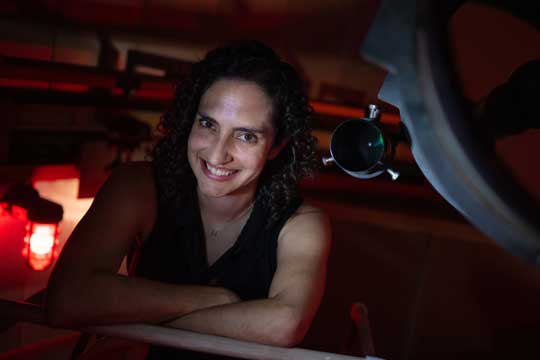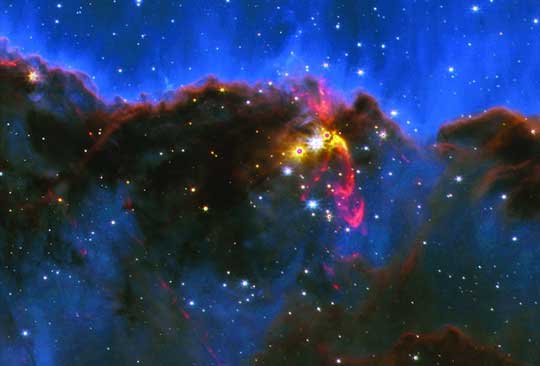HOUSTON – (Dec. 16, 2022) – Rice University astronomer Megan Reiter and colleagues took a “deep dive” into one of the first images from NASA’s James Webb Space Telescope and were rewarded with the discovery of telltale signs from two dozen previously unseen young stars about 7,500 light years from Earth.

The published research in the December issue of the Monthly Notices of the Royal Astronomical Society offers a glimpse of what astronomers will find with Webb’s near-infrared camera. The instrument is designed to peer through clouds of interstellar dust that have previously blocked astronomers’ view of stellar nurseries, especially those that produce stars similar to Earth’s sun .
Reiter, an assistant professor of physics and astronomy, and co-authors from the California Institute of Technology, the University of Arizona, Queen Mary University in London and the United Kingdom’s Royal Observatory in Edinburgh, Scotland, analyzed a portion of Webb’s first images of the Cosmic Cliffs , a star-forming region in a cluster of stars known as NGC 3324.

“What Webb gives us is a snapshot in time to see just how much star formation is going on in what may be a more typical corner of the universe that we haven’t been able to see before,” said Reiter, who led the study.
Located in the southern constellation Carina, NGC 3324 hosts several well-known regions of star formation that astronomers have studied for decades. Many details from the region have been obscured by dust in images from the Hubble Space Telescope and other observatories. Webb’s infrared camera was built to see through dust in such regions and to detect jets of gas and dust that spew from the poles of very young stars.
Reiter and colleagues focused their attention on a portion of NGC 3324 where only a few young stars had previously been found. By analyzing a specific infrared wavelength, 4.7 microns, they discovered two dozen previously unknown outflows of molecular hydrogen from young stars. The outflows range in size, but many appear to come from protostars that will eventually become low-mass stars like Earth’s sun.
“The findings speak both to how good the telescope is and to how much there is going on in even quiet corners of the universe,” Reiter said.
Within their first 10,000 years, newborn stars gather material from the gas and dust around them. Most young stars eject a fraction of that material back into space via jets that stream out in opposite directions from their poles. Dust and gas pile up in front of the jets, which clear paths through nebular clouds like snowplows. One vital ingredient for baby stars, molecular hydrogen, gets swept up by these jets and is visible in Webb’s infrared images.

“Jets like these are signposts for the most exciting part of the star formation process,” said study co-author Nathan Smith of the University of Arizona. “We only see them during a brief window of time when the protostar is actively accreting.”
The accretion period of early star formation has been especially difficult for astronomers to study because it is fleeting — usually just a few thousand years in the earliest portion of a star’s multimillion-year childhood.
Study co-author Jon Morse of the California Institute of Technology said jets like those discovered in the study “are only visible when you embark on that deep dive — dissecting data from each of the different filters and analyzing each area alone.
“It’s like finding buried treasure,” Morse said.
Reiter said the size of the Webb telescope also played a role in the discovery.
“It's just a huge light bucket,” Reiter said. “That lets us see smaller things that we might have missed with a smaller telescope. And it also gives us really good angular resolution. So we get a level of sharpness that allows us to see relatively small features, even in faraway regions.”
The Webb Space Telescope program is led by NASA in partnership with the European Space Agency (ESA) and the Canadian Space Agency (CSA). The telescope’s science and mission operations are led by the Space Telescope Science Institute (STScI) in Baltimore.
The research was supported by NASA (NAS 5-0312, NAS 5–26555), STScI and a Dorothy Hodgkin Fellowship from the UK’s Royal Society.
- Peer-reviewed paper
-
“Deep diving off the ‘Cosmic Cliffs’: previously hidden outflows in NGC 3324 revealed by JWST” | Monthly Notices of the Royal Astronomical Society | DOI: 10.1093/mnras/stac2820
Megan Reiter, Jon A. Morse, Nathan Smith, Thomas J. Haworth, Michael A. Kuhn and Pamela D. Klaassen
- Image downloads
-
https://news-network.rice.edu/news/files/2022/12/1215_COSMIC-f2a-lg.jpg
CAPTION: Astronomers from Rice University and other organizations dug deep into the data from this near-infrared image, one of the first taken by NASA’s James Webb Space Telescope. The image shows a star-forming region in the constellation Carina known as the Cosmic Cliffs. Many newborn stars in such regions are shrouded in thick clouds of dust. Webb’s infrared camera penetrated the dust, allowing astronomers to discover telltale signs of two dozen infant stars that hadn’t been previously detected. (Image courtesy of NASA, ESA, CSA and STScI)
https://news-network.rice.edu/news/files/2022/12/1215_COSMIC-mr9Fit-lg.jpg
CAPTION: Rice University astronomer Megan Reiter led a “deep dive” study of the earliest images from the James Webb Space Telescope. The research revealed telltale signs of two dozen previously uncataloged young stars in the star cluster NGC 3324 in the constellation Carina. (Photo by Jeff Fitlow/Rice University)
https://news-network.rice.edu/news/files/2022/12/1215_COSMIC-f2b-lg.jpg
CAPTION: Matter flows away from the poles of newborn stars in fast-moving columns that plow through nebular clouds. Gas and dust pile up in front of these outflows, forming waves called “bow shocks” in much the same way that bow waves form at the leading edge of seagoing ships. This false-color infrared image from the James Webb Space Telescope shows bow shocks of molecular hydrogen (red) streaming away from newborn stars in a star-forming region called the Cosmic Cliffs in the southern constellation Carina. (Image courtesy of NASA, ESA, CSA and STScI) - Related stories
-
Gemini South’s high-def version of ‘A Star is Born’ – Oct. 5, 2020
https://news.rice.edu/news/2020/gemini-souths-high-def-version-star-bornMoon-forming disk discovered around distant planet - July 11, 2019
https://news2.rice.edu/2019/07/11/moon-forming-disk-discovered-around-distant-planet/Direct from distant planet: Spectral clues to puzzling paradox – June 10, 2019
https://news2.rice.edu/2019/06/10/direct-from-distant-planet-spectral-clues-to-puzzling-paradox/Carina Nebula survey reveals details of star formation – March 9, 2015
https://news2.rice.edu/2015/03/09/carina-nebula-survey-reveals-details-of-star-formation/Hubble movies reveal solar-system-sized traffic jams – Aug. 31, 2011
https://news2.rice.edu/2011/09/07/hubble-movies-reveal-solar-system-sized-traffic-jams/ - About Rice
-
Located on a 300-acre forested campus in Houston, Rice University is consistently ranked among the nation’s top 20 universities by U.S. News & World Report. Rice has highly respected schools of Architecture, Business, Continuing Studies, Engineering, Humanities, Music, Natural Sciences and Social Sciences and is home to the Baker Institute for Public Policy. With 4,240 undergraduates and 3,972 graduate students, Rice’s undergraduate student-to-faculty ratio is just under 6-to-1. Its residential college system builds close-knit communities and lifelong friendships, just one reason why Rice is ranked No. 1 for lots of race/class interaction and No. 1 for quality of life by the Princeton Review. Rice is also rated as a best value among private universities by Kiplinger’s Personal Finance.

